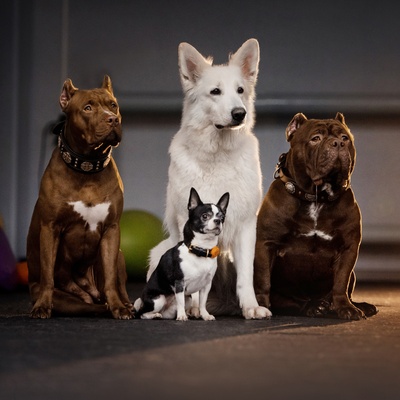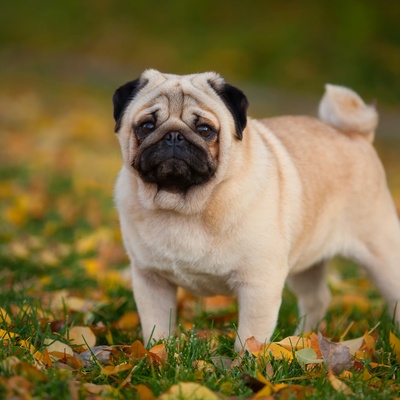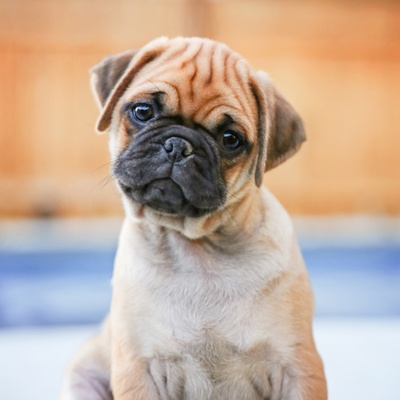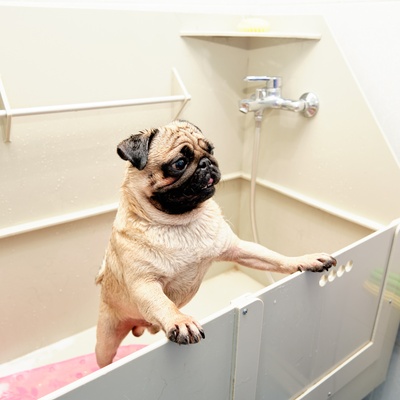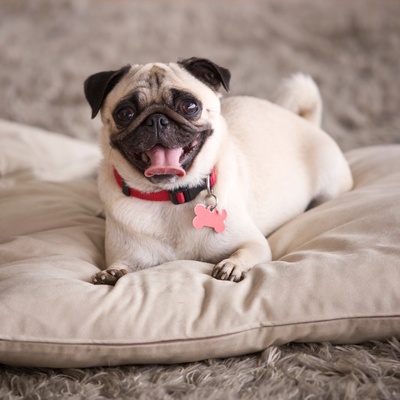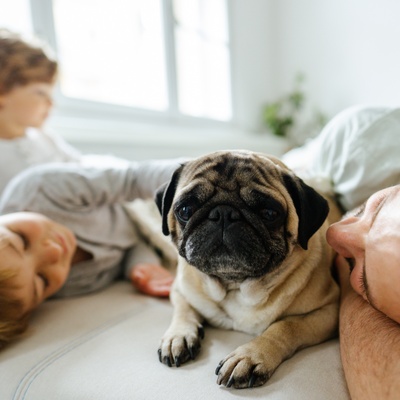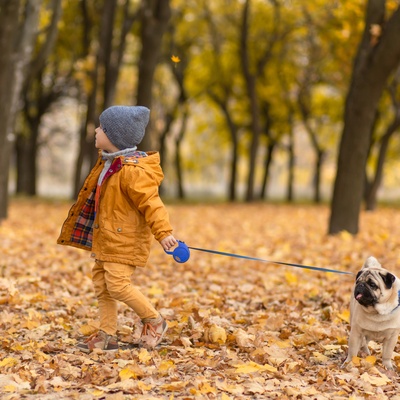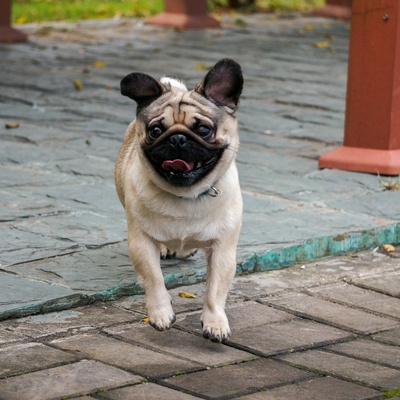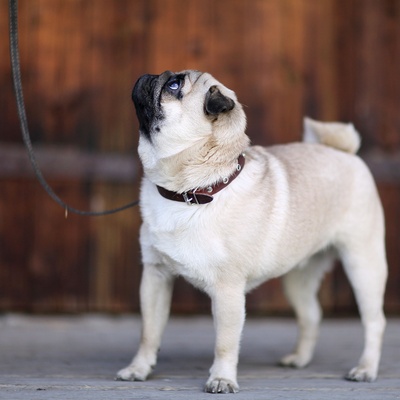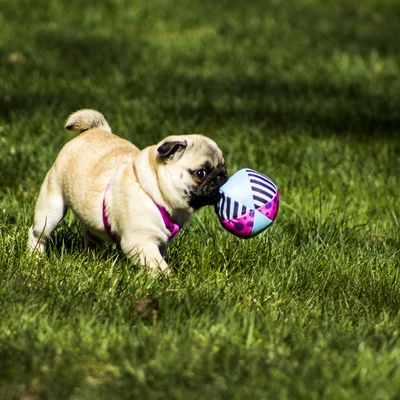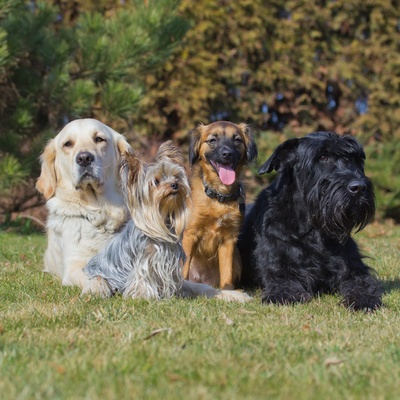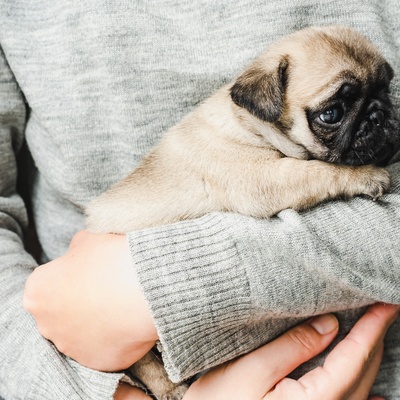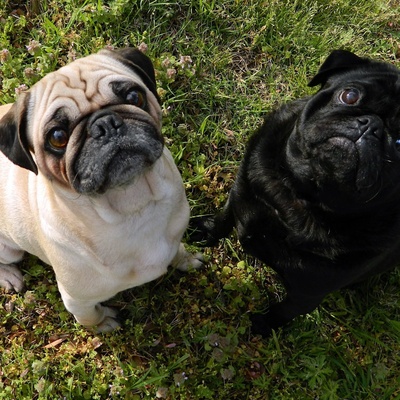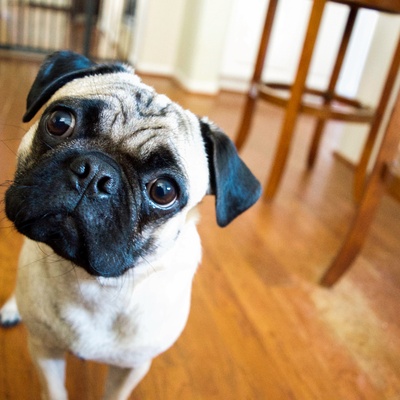Introducing the Pug
Discover all there is to know about the Pug : its characteristics, behavior, training, and its cost.

Discover all there is to know about the Pug : its characteristics, behavior, training, and its cost.
The Pug's lineage dates back to ancient China, where they were cherished by emperors and nobility alike, often adorned with their own miniature palaces. This breed's journey westward turned it into a beloved companion across continents, and today, it stands as one of the most adored small dog breeds in the UK.
Pugs are happy snuggling on a lap as they are playing with children, making them the perfect pet for families and individuals alike.
This section outlines the unique features of the Pug breed.
The Pug belongs to the toy group (group 9), cherished for their companionship and adored for their small stature and expressive faces.
Pugs are charmingly compact, typically weighing between 14 to 18 pounds and standing about 10 to 13 inches tall at the shoulder.
This breed boasts a short, smooth coat that is easy to groom while being known for its double-layered warmth.
Pugs commonly don a fine coat in shades of fawn or black, with possible variations ranging from apricot fawn to silver fawn.
Pugs are adaptable and do well in apartments as well as houses, thriving on human companionship.
Renowned for their friendly nature, Pugs are sociable with humans and other pets, making them great companions for children.
Generally a robust breed, Pugs can be prone to certain genetic conditions, including brachycephalic syndrome and hip dysplasia.
Pugs are known for their even-tempered and charming personalities, responding well to training that is consistent and positive.
We can help!
Every dog has its own character, and so do you. Making the right choice will ensure his well-being and yours.
Take our quiz to find out which breed is right for you, based on your personality, lifestyle, location and many other criteria.
Don't wait any longer and take the quiz to find out the answer!
Pugs may be small, but they pack a punch when it comes to personality and presence. Their distinctive coat, often a sleek silver or apricot fawn, complements their famously expressive, wrinkled faces.
Pugs are petite pooches, with females typically measuring 10 to 12 inches, and males reaching a regal 12 to 14 inches.
In terms of weight, female Pugs tip the scales at a dainty 13 to 15 pounds, while males can weigh a sturdy 14 to 18 pounds.
Pug puppies grow rapidly in their first year, hitting most of their growth milestones. By the age of one, they've generally reached their full size and weight, ready to charm the world as fully-grown mini monarchs.
The Pug sports a short, smooth coat that stands out for its softness and sleekness. Despite its length, the coat is double-layered, providing a surprising amount of warmth and texture to the touch.
Pugs are often recognized for their fawn or black coats, but they can also sport shades of apricot or silver, giving them a distinguished look.
Pugs have a low-maintenance coat that requires regular brushing due to the shedding of their thick undercoat. They shed year-round, with seasonal peaks, necessitating more frequent grooming sessions during these times.
To maintain their neat appearance and manage shedding, a weekly brushing routine is recommended, increasing to daily during periods of heavy shedding. Baths can be given monthly, or as needed, to keep their coat clean and shiny, while being mindful of their sensitivity to both cold and heat due to their short coats.
The Pug is a model of canine charm with a well-rounded, sturdy frame that embodies balance and proportion. The head is large and round with no sharp angles, and their flat face is a tapestry of wrinkles, each telling a story of ancient lineage. Their eyes are one of their most captivating features, large, round, and dark, exuding an almost human-like expression of depth and emotion.
The ears, small and soft, fold neatly above the creased visage. Despite their compact size, Pugs possess a surprisingly muscular and stocky body, with a straight and strong backline leading to a high-set, curling tail that perfectly rounds off their distinctive silhouette.
The Pug is renowned for its affectionate, playful nature and is a loyal companion that brings warmth and joviality to any home.
Among the hundreds of dog breeds recognized globally, grouped into specific categories, the Pug holds a special place.
The Pug falls under the toy group (group 9), a category that includes breeds like Chihuahuas, Pomeranians, and Yorkshire Terriers. These breeds are characterized by their diminutive size, engaging personalities, and suitability for companionship rather than physical labor.
Pugs are charming companions, known for their playful and often mischievous behavior. They show boundless affection towards their owners, always eager to give and receive love.
Pugs require an owner who can be present and engaged, as their emotional well-being is closely tied to human interaction. Despite their small size, they have a big presence and enjoy a bit of independence, but they will never stray too far from their beloved human's side.
Pugs are social creatures through and through, exuding warmth and generosity in their interactions. They are excellent with humans, including strangers, greeting everyone as a friend.
Their gentle nature makes them superb companions for children, embodying patience and playfulness in equal measure. To harness their sociability, it's crucial to introduce Pugs to various social situations from a young age, ensuring they grow up to be well-adjusted and sociable adults.
Pugs are remarkably adaptable and can thrive in various settings, from cozy apartments to spacious country homes. While they don't demand vast spaces, the presence and attention of their owner are crucial to their contentment.
Pugs typically require moderate exercise; short walks about 15 to 20 minutes each, a couple of times a day, should suffice to keep them healthy and happy.
Despite their adaptability to indoor living, Pugs benefit from having access to a secure outdoor area where they can explore and play.
While they're not as high-energy as some breeds, having the option to sniff around and enjoy the outdoors satisfies their curiosity and helps maintain their mental and physical well-being.
Pugs are eager to please, which can make training a rewarding experience. They may not possess the same level of intelligence as some working breeds, but with patience and consistency, they learn well.
Due to their sensitive nature, positive reinforcement methods work best. Given their small size and sociable nature, outfitting a Pug with a GPS collar from Weenect can offer peace of mind, ensuring their safety during outdoor adventures and potential escapades.
Pugs have a unique way of listening that may require an understanding of their laid-back and sometimes stubborn character. They respond best to short, engaging training sessions that are fun and rewarding.
Focusing on their strong desire for companionship can be beneficial, as they are more likely to follow commands when they perceive them as part of a bonding experience.
Take the test and find out the dog breed that matches your personality and lifestyle.
Pugs are generally robust little dogs, but like any breed, they benefit immensely from daily care that focuses on disease and infection prevention.
Pugs are known for their overall good health, though they have certain breed-specific challenges. Prone to brachycephalic syndrome due to their flat faces, they can also experience skin fold dermatitis, eye conditions, and respiratory issues.
Pugs may also be susceptible to obesity without proper diet and exercise. The typical lifespan of a Pug ranges from 12 to 15 years, contingent on their health and lifestyle.
Regular veterinary visits are paramount for the Pug's health, ensuring they stay up-to-date with vaccinations, deworming, and flea treatments.
Daily care routines are vital and should include coat brushing, ear cleaning to prevent infection, dental hygiene to ward off periodontal disease, and nail trimming to avoid overgrowth and discomfort.
Being vigilant about potential allergies is also key; consult your vet for tailored advice. Pugs are not hypoallergenic and may shed significantly, so regular grooming is essential.
Every Pug requires a balanced diet rich in proteins and vitamins to maintain their well-being. Premium kibble specifically formulated for small breeds can serve as a solid dietary base for a Pug.
For those Pugs with a more active lifestyle or higher protein requirements, incorporating lean meats such as chicken or fish can be beneficial, but it's important to keep an eye on the fat content to prevent weight gain.
Pugs, with their hearty appetites, can be prone to overeating. It's crucial to establish a regular feeding schedule and adhere to recommended portion sizes to avoid obesity.
The Pug is a well-regarded breed with many admirers and is available through numerous breeders. It's important to consider several factors before adopting.
Prior to welcoming a Pug into your home, it's essential to make an informed decision. Finding a reputable breeder is crucial; visit their facility to observe the puppies' living conditions and behavior. Health is paramount, so ask for transparency regarding the puppy's and its parents' health status.
Lastly, you must have your dog microchipped by the age of 8 weeks old and have their details registered on a relevant database likePetlog or Animal Tracker. This is a legal requirement in Great Britain and failing to comply could result in a £500 fine. Microchipping can be done by your vet for a small fee, or for free at any Blue Cross center.
The initial cost of a Pug can vary widely based on the breeder's reputation, the dog's lineage and pedigree, and even the dog's age. You might expect to pay anywhere from
to
for a Pug puppy.
Remember, owning a Pug comes with ongoing expenses for their care, including food, veterinary check-ups, and other necessities, which can average between
and
annually.
Choosing a dog that matches your personality and lifestyle will ensure your well-being and his!
To access the most relevant information, suitable payment methods, and delivery in your region, please select the website corresponding to your country.

